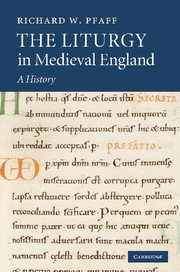Book contents
- Frontmatter
- Contents
- Preface
- Sigla and editorial conventions
- Bibliographical abbreviations
- Nicknames for manuscripts frequently referred to
- 1 Introduction
- Excursus: on sources
- 2 Early Anglo-Saxon England: a partly traceable story
- Excursus: on the terms Gregorian and Gelasian as used here
- 3 Later Anglo-Saxon: liturgy for England
- 4 The Norman Conquest: cross fertilizations
- Excursus: on method in the comparison of liturgical texts
- 5 Monastic liturgy, 1100–1215
- Excursus: on ascription of liturgical books to specific churches
- 6 Benedictine liturgy after 1215
- 7 Other monastic orders
- 8 The non-monastic religious orders: canons regular
- 9 The non-monastic religious orders: friars
- Excursus: on liturgical books from female religious houses
- 10 Old Sarum: the beginnings of Sarum Use
- 11 New Sarum and the spread of Sarum Use
- 12 Exeter: the fullness of secular liturgy
- 13 Southern England: final Sarum Use
- 14 Regional Uses and local variety
- 15 Towards the end of the story
- Index of Manuscripts
- Index of Saints
- General Index
2 - Early Anglo-Saxon England: a partly traceable story
Published online by Cambridge University Press: 20 March 2010
- Frontmatter
- Contents
- Preface
- Sigla and editorial conventions
- Bibliographical abbreviations
- Nicknames for manuscripts frequently referred to
- 1 Introduction
- Excursus: on sources
- 2 Early Anglo-Saxon England: a partly traceable story
- Excursus: on the terms Gregorian and Gelasian as used here
- 3 Later Anglo-Saxon: liturgy for England
- 4 The Norman Conquest: cross fertilizations
- Excursus: on method in the comparison of liturgical texts
- 5 Monastic liturgy, 1100–1215
- Excursus: on ascription of liturgical books to specific churches
- 6 Benedictine liturgy after 1215
- 7 Other monastic orders
- 8 The non-monastic religious orders: canons regular
- 9 The non-monastic religious orders: friars
- Excursus: on liturgical books from female religious houses
- 10 Old Sarum: the beginnings of Sarum Use
- 11 New Sarum and the spread of Sarum Use
- 12 Exeter: the fullness of secular liturgy
- 13 Southern England: final Sarum Use
- 14 Regional Uses and local variety
- 15 Towards the end of the story
- Index of Manuscripts
- Index of Saints
- General Index
Summary
The difficulty of trying to begin our story at its chronological beginning, unavoidable if we are to pursue an historical rather than merely descriptive method, may be succinctly expressed by reminding ourselves of approaches taken in two of the greatest works ever to deal with England in the middle ages. The first approach is summed up in the often-quoted epigrammatic statement of Frederic William Maitland in explaining the title of his Domesday Book and Beyond: “Domesday Book appears to me, not indeed as the known, but as the knowable. The Beyond is still very dark: but the way to it lies through the Norman record. A result is given to us: the problem is to find cause and process.” The second is expressed in Dom David Knowles's explanation of why he began his Monastic Order in England no earlier than the mid-tenth century: that a continuous history of English Benedictine monasticism (his primary concern) is possible only from the time of Dunstan and his contempo raries because, despite the glowing witness of Bede, for the earlier period “the records of the times and places of which the Venerable Bede does not treat are in general so imperfect and of such questionable authenticity that an intensive critical and diplomatic investigation by specialists must precede any fresh attempt to understand the conditions under which the monks lived.”
In matters liturgical as well as monastic much investigation of the “critical and diplomatic” sort has been accomplished in the sixty-plus years since Knowles wrote; but the partial and unsteady state of our knowledge of the liturgy in England before the so-called Monastic Reform still compels a treatment of the earlier Anglo-Saxon…
- Type
- Chapter
- Information
- The Liturgy in Medieval EnglandA History, pp. 30 - 55Publisher: Cambridge University PressPrint publication year: 2009



